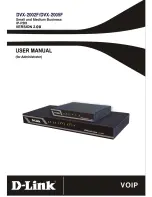
•
Calls made by accessing a trunk via an S-CO button or Trunk Group Access feature number, etc. cannot
use enhanced QSIG features because they do not refer to the TIE Table. This includes calls made from
the call history of Communication Assistant (CA) because such calls specify a trunk group directly.
•
Calls forwarded using Call Forwarding (CF)—by QSIG cannot use enhanced QSIG features.
•
Leave Message Waiting
Over a network, the Message Waiting set/cancel/callback feature number cannot be used to set or cancel
Message Waiting.
•
Executive Busy Override
When executive busy override is used to interrupt a call between an extension in another PBX and an
outside caller to make a 3-party conference call, and then the extension in the other PBX leaves the
conversation, the call will be considered a trunk-to-trunk call. If enabled through system programming, the
call will be terminated at this time.
•
Directed Call Pickup
–
When dialling using the PBX Code Method (Access with PBX Code)
Dial as follows: [TIE Line Access Number] + [PBX Code of ringing extension] + [Directed Call Pickup
feature number] + [Ringing extension number].
For example, to pick up the ringing extension 101 that is in another PBX with the PBX Code 123, you
would dial "7-123- 41-101".
–
When dialling using the Extension Number Method (Access without PBX Code)
Dial as follows: [All but last digit of the ringing extension ] + [Directed Call Pickup feature
number] + [Ringing extension number].
For example, to pick up the ringing extension 321 over a network, dial "32 - 41-321".
–
To use Directed Call Pickup over a VoIP network using Common Extension Numbering for Multiple
PBXs, the operation must be predialled, or executed using CTI.
PC Programming Manual References
10.9 PBX Configuration—[2-9] System—System Options—Option 2—
Conference
17.1 PBX Configuration—[9-1] Private Network—TIE Table—Enhanced QSIG
Feature Manual
451
4.3.5 QSIG Enhanced Features
Summary of Contents for KX-NS700
Page 16: ...16 Feature Manual Table of Contents...
Page 17: ...Section 1 For Your Safety Feature Manual 17...
Page 20: ...20 Feature Manual 1 1 1 For Your Safety...
Page 21: ...Section 2 Call Handling Features Feature Manual 21...
Page 59: ...632 Maximum Number of Agents Feature Manual 59 2 2 2 Incoming Call Distribution Group Features...
Page 109: ...Operating Manual References 1 2 1 Basic Calling Feature Manual 109 2 5 4 Trunk Call Features...
Page 195: ...Operating Manual References 1 4 2 Holding a Call Feature Manual 195 2 13 1 Call Hold...
Page 326: ...326 Feature Manual 2 30 2 Outgoing Message OGM...
Page 327: ...Section 3 Unified Messaging System Feature Manual 327...
Page 377: ...Section 4 Network Features Feature Manual 377...
Page 466: ...466 Feature Manual 4 3 6 Network ICD Group...
Page 467: ...Section 5 System Configuration and Administration Features Feature Manual 467...
Page 560: ...560 Feature Manual 5 5 7 PING Confirmation...
Page 561: ...Section 6 Appendix Feature Manual 561...
Page 578: ...578 Feature Manual 6 5 6 PFMPR Software File Version 004 6xxxx...
Page 579: ...Feature Manual 579 Notes...

































